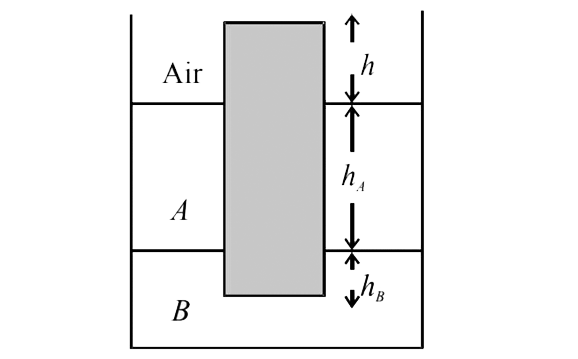Two immiscible of densities 2.5g/cm3 and 0.8g/cm3 are taken in the ratio of their masses as 2:3 respectively find the average density of the liquid conbination.
To find the average density of a combination of two immiscible liquids with given densities and mass ratios, we can follow these steps:
1. Identify the Given Data:
- Density of liquid 1, ρ1=2.5g/cm3
- Density of liquid 2, ρ2=0.8g/cm3
- Mass ratio of the two liquids = 2:3
2. Assign Masses Based on the Ratio:
- Let the mass of liquid 1 be 2m and the mass of liquid 2 be 3m.
3. Calculate the Volume of Each Liquid:
- Volume of liquid 1, V1=massdensity=2m2.5=2m2.5=4m5cm3
- Volume of liquid 2, V2=massdensity=3m0.8=3m0.8=30m8=15m4cm3
4. Calculate the Total Volume:
- Total volume, V=V1+V2=4m5+15m4
- To add these fractions, find a common denominator. The least common multiple of 5 and 4 is 20.
- Convert V1 and V2 to have a common denominator:
- V1=4m5=16m20
- V2=15m4=75m20
- Now, add them:
- V=16m20+75m20=91m20cm3
5. Calculate the Total Mass:
- Total mass, M=2m+3m=5m
6. Calculate the Average Density:
- Average density, ρ=Total massTotal volume=MV=5m91m20
- Simplifying this gives:
- ρ=5m⋅2091m=10091g/cm3
7. Final Calculation:
- Thus, the average density is approximately:
- ρ≈1.1g/cm3
Final Answer:
The average density of the liquid combination is approximately 1.1g/cm3.
- Density of liquid 1, ρ1=2.5g/cm3
- Density of liquid 2, ρ2=0.8g/cm3
- Mass ratio of the two liquids = 2:3
- Let the mass of liquid 1 be 2m and the mass of liquid 2 be 3m.
- Volume of liquid 1, V1=massdensity=2m2.5=2m2.5=4m5cm3
- Volume of liquid 2, V2=massdensity=3m0.8=3m0.8=30m8=15m4cm3
- Total volume, V=V1+V2=4m5+15m4
- To add these fractions, find a common denominator. The least common multiple of 5 and 4 is 20.
- Convert V1 and V2 to have a common denominator:
- V1=4m5=16m20
- V2=15m4=75m20
- Now, add them:
- V=16m20+75m20=91m20cm3
- Total mass, M=2m+3m=5m
- Average density, ρ=Total massTotal volume=MV=5m91m20
- Simplifying this gives:
- ρ=5m⋅2091m=10091g/cm3
- Thus, the average density is approximately:
- ρ≈1.1g/cm3
The average density of the liquid combination is approximately 1.1g/cm3.
Topper's Solved these Questions
- ELASTICITY, SURFACE TENSION AND FLUID MECHANICSBOOK - ALLENCHAPTER - ELASTICITY, SURFACE TENSION AND FLUID MECHANICSEXERCISE - Exercise 1 (Elasticity)
16 Videos
- ELASTICITY, SURFACE TENSION AND FLUID MECHANICSBOOK - ALLENCHAPTER - ELASTICITY, SURFACE TENSION AND FLUID MECHANICSEXERCISE - Exercise 1 (Surface Tension)
21 Videos
- CENTRE OF MASSBOOK - ALLENCHAPTER - CENTRE OF MASSEXERCISE - EXERCISE-V B
19 Videos
- ERROR AND MEASUREMENTBOOK - ALLENCHAPTER - ERROR AND MEASUREMENTEXERCISE - Part-2(Exercise-2)(B)
22 Videos
Similar Questions
A beaker contains 262.5cm3 of a certain liquid and weighs 420 g. If the mass of an empty dry beaker is 210 g, find the density of the liquid.
View SolutionTwo discs of same mass and same thickness have densities as 17g/cm3 and 51g/cm3. The ratio of their moment of inertia about their central axes is
View Solution
Knowledge Check
The density of aluminium is 2.7gcm−3 and of brass is 84gcm−3 . For the same mass, the volume of :
Aboth will be sameBaluminium will be less than that of brassCaluminium will be more than that of brassDnothing can be said.
Two solids A and B of density 2.5 g cm−3 and 0.80g cm−3 are placed in a liquid L of density 1.2 g cm−3 Which solid is likely to float and why?
View SolutionDensity of an object is g/cm3. Express it in kg/m3.
View SolutionA body of density 2.5g/cm3 is let free in a liquid of density 1.25g/cm3 . The downward acceleration of the of the body while sinking in the liquid is . _______
View SolutionA uniform solid cylinder of density 0.8g/cm3 floats in equilibrium in a combination of two non-mixing liquids A and B with its axis vertical.
The densities of the liquids A and B are 0.7g/cm3 and 1.2g/cm3, respectively. The height of liquid A is hA=1.2cm. The length of the part of the cylinder immersed in liquid B is hB=0.8cm.

(a) Find the total force exerted by liquid A on the cylinder.
(b) Find h, the length of the part of the cylinder in air.
(c) The cylinder is depressed in such a way that its top surface is just below the upper surface of liquid A and is then released. Find the acceleration of the cylinder immediately after it is released.
View SolutionA uniform solid cylinder of density 0.8g/cm3 floats in equilibrium in a combination of two non-mixing liquids A and B with its axis vertical.
The densities of the liquids A and B are 0.7g/cm3 and 1.2g/cm3, respectively. The height of liquid A is hA=1.2cm. The length of the part of the cylinder immersed in liquid B is hB=0.8cm.

(a) Find the total force exerted by liquid A on the cylinder.
(b) Find h, the length of the part of the cylinder in air.
(c) The cylinder is depressed in such a way that its top surface is just below the upper surface of liquid A and is then released. Find the acceleration of the cylinder immediately after it is released.
View SolutionA uniform solid cylinder of density 0.8g/cm3 floats in equilibrium in a combination of two non-mixing liquids A and B with its axis vertical.
The densities of the liquids A and B are 0.7g/cm3 and 1.2g/cm3, respectively. The height of liquid A is hA=1.2cm. The length of the part of the cylinder immersed in liquid B is hB=0.8cm.

(a) Find the total force exerted by liquid A on the cylinder.
(b) Find h, the length of the part of the cylinder in air.
(c) The cylinder is depressed in such a way that its top surface is just below the upper surface of liquid A and is then released. Find the acceleration of the cylinder immediately after it is released.
View SolutionThe mass of 5 litre of water is 5 kg. Find the density of water in g cm−3
View Solution
